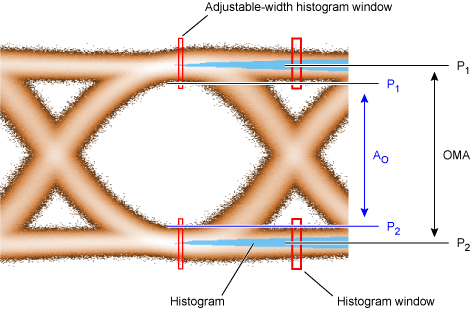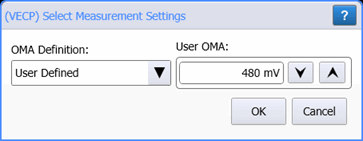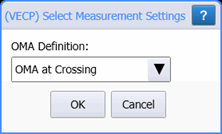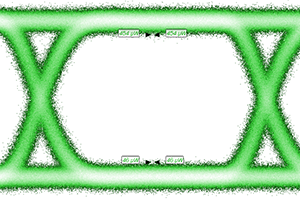VECP
 The Eye mode VECP is the measure of the Vertical Eye Closure Penalty (VECP) in dB of an optical signal. Because the VECP measurement uses an OMA measurement to calculate VECP, you are prompted to select how the OMA value is obtained: estimated or user defined (measured). By default, the VECP measurement automatically performs Eye mode's OMA at Crossing measurement to get an estimation of OMA. This is explained in OMA Measurement Options below.
The Eye mode VECP is the measure of the Vertical Eye Closure Penalty (VECP) in dB of an optical signal. Because the VECP measurement uses an OMA measurement to calculate VECP, you are prompted to select how the OMA value is obtained: estimated or user defined (measured). By default, the VECP measurement automatically performs Eye mode's OMA at Crossing measurement to get an estimation of OMA. This is explained in OMA Measurement Options below.
The estimated OMA at Crossing measurement measures the Optical Modulation Amplitude (OMA) at the eye diagram's crossing points. As shown in the following picture, two histogram windows are placed in time at the eye's crossing points, which occurs at adjacent one and adjacent zero levels. The resulting histogram gives the mathmatical mean of the one power level (P1) and mean of the zero power level (P0) in μW. OMA is the difference between the two means.
Once the OMA in known, the VECP measurement which complies to the standard places histograms windows at 0.5 UI for both the one level and zero level as shown in the following picture. The width of these histogram windows is adjustable as explained in Configure Base Measurements Settings in this topic. Histograms are used to locate the eye's vertical opening at the eye's center time between 99.95% of the lower histogram and 0.05% of the upper histogram. This is shown as AO in the figure. VECP is then calculated using this equation:
VECP = 10 log(OMA / A0)

Keysight recommends using Jitter Mode's NRZ VEC measurement whenever possible.
OMA Measurement Options
- User Defined OMA (Oscilloscope mode's OMA measurement)
- This is the recommended selection. With this selection, you first must perform an Oscilloscope mode OMA measurement and enter the resulting value as the user-defined OMA for the VECP measurement. OMA is the difference between the optical power of an NRZ one pulse and the optical power of an NRZ zero pulse. The Oscilloscope OMA measurement is designed to be made using an NRZ pattern that contains consecutive runs of ones and zeros as called out in many standards. This pattern allows the one and zero levels to settle out to minimize the effect of level transitions.

- OMA at Crossing (Eye mode's OMA at Crossing measurement)
- This is the default setting. The OMA value is automatically derived during the VECP measurement using the OMA at Crossing measurement. Since a pattern of consecutive ones and zeros is not used during the OMA measurement (as is done when entering a user-defined OMA value), the resulting VECP measurement can be too optimistic.

Configure Base Measurements Settings
The VECP measurement is affected by the TDEC/VECP Histogram Width setting that is located in the TDEC/VECP tab of the Configure Measurements dialog (click Measure > Configure Base Measurements). The other entries in the dialog do not affect the VECP measurement.
- VECP Histogram Width. Adjust this setting when FlexDCA is not in pattern lock. It adjusts the histogram window so that additional data can be acquired to decrease the measurement time. The window's width can be set from 0.01 UI to 0.20 UI. The default setting is 0.04 UI.
| Minimum Width (0.01 UI) | Maximum Width (0.20 UI) |
|---|---|

|

|
To measure
- Select Eye/Mask Mode.
- Click the toolbar's Eye Meas tab.
- Click Auto Scale in the menu bar.
- Click the More buttons to locate the VECP button.
- Click the button.
SCPI Command
:MEASure:EYE:VECP